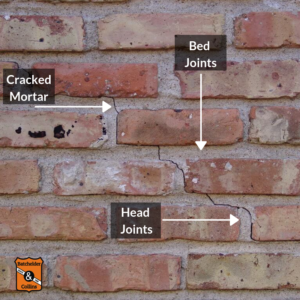How to Repair Mortar Between Bricks

Most often, this manifests itself in the need to fix the mortar that holds the bricks together, which can crack, recede, and fall out of the joints over time. If you don’t take care of this, the wall can eventually collapse and we certainly don’t want that. It’s time to chisel out the old stuff and patch it up with fresh mortar and while this is a pretty easy job, it has to be done with care – and the right tools. So today, we will walk you through the steps of repairing the mortar in your brick wall, a process formally called repointing.
How to Pick the Best Mortar for Your Brick Wall
The age of your brick home is the deciding factor in what type of mortar to buy and use to repoint your wall. If your brick is 50 years old or younger, you can safely repair it with standard, cement-based mortar. But, if your house was built before World War II, the mortar is likely a mix of lime putty and sand, designed for historic brick structures and you will have to match it. If not, the soft, old bricks will swell and shrink against the hard, new mortar which will cause the bricks to break and fall out of the wall over time. Lime mortar acts as more of a cushion, flexing with the brick as it absorbs moisture then releases it.
Step 1: Clear Out the Bed Joints
With your safety mask and goggles on, use either a hammer and cold chisel or utility chisel to remove the old mortar in the horizontal (bed) joints. You’ll want to avoid using electric angle grinders, which we can almost guarantee will result in disfigured bricks, unless you are properly trained.
The amount of mortar to scrape out is dependent upon how deep the damaged mortar goes. Scrape out at least ¾ inch.
Step 2: Clear Out the Head Joints
After removing the bed-joint mortar, dig out the vertical (head) joints. Be wary not to hit the edges of the brick above or below.
Step 3: Clean Down the Wall
Now you’ll want to brush away the crumbly debris that clearing the joints left behind using a stiff-bristled brush. Then mist the wall with a hose until the brick is thoroughly damp and the water starts to drip off. This is especially important because dry brick will suck the moisture out of the new mortar, preventing it from curing correctly. Wait 24 hours before you start filling the joints.
Step 4: Mix the Mortar
Before you start filling the joints, check the blade of your tuck-pointing trowel (the tool you will use to fill the joints with fresh mortar) to make sure it fits into the joints. If the blade is too wide, grind it down using an abrasive wheel.
Following the directions on the bag of mortar, gradually stir water into the dry mix until it reaches the consistency of peanut butter and clings to the trowel when you hold it upside down. Allow the mortar to rest for 10-15 minutes until a film of water forms on the top of the mix. Stir the water back into the mix before you start. The mortar is now ready for use and remains workable for 8 hours; if it gets too dry during that time, you can add a bit of water occasionally.
Step 5: Fill the Joints with Mortar
Load mortar onto a brick trowel, hold the trowel up to the horizontal joint close to the brick and push the mortar into the joint using the tuck-pointing trowel. Sweep about ¼ inch slivers of mortar into the cavity at a time, filling the horizontal joints first.
Here are some additional tips to help you in filling mortar joints:
- Pack the mortar tightly by passing the trowel’s edge across the mortar a few times to eliminate voids then add more mortar until the joint is filled. This will result in the strongest, most water-resistant joints possible.
- Fill deeper joints (¾ inches or greater) in two stages, allowing the first layer to harden before adding the second layer.
- Once you’ve finished three or four courses of bed joints, now go through and fill the head joints. Smooth and compact all the mortar with the trowel’s flat face.
- As you’re going, avoid getting mortar on the brick face but any excess mortar can be wiped away with a mortar brush.
- The weather has a huge impact on this process: don’t work in temperatures below 40⁰F. In hot weather, start repointing in shaded areas first so the sun doesn’t dry the mortar too fast. And only mix the mortar in small batches as you go.
Step 6: Clean the Bricks with a Brush
Using a soft-bristled brush, remove the excess mortar clusters that have formed on the brick face before they harden and sweep away loose mortar from the finished joints. Brush diagonally so that you are not disturbing the fresh mortar.
For the next two days, mist the new mortar twice a day with a hand pump sprayer or light mist setting on a garden hose to help it dry properly. Use a tarp to protect the new mortar from the sun, wind, or harsh rain.
Now step back and appreciate the new look of your brick house. And remember, for all your brick needs, Batchelder & Collins has got you covered.
Enjoy Your Backyard All Fall Long

Now is the perfect time to take advantage of autumn’s mild days to prepare your backyard for the cold months ahead. But who’s to say you can’t still enjoy your backyard, spending time with your family, and cooking outdoors all fall long.
"*" indicates required fields



